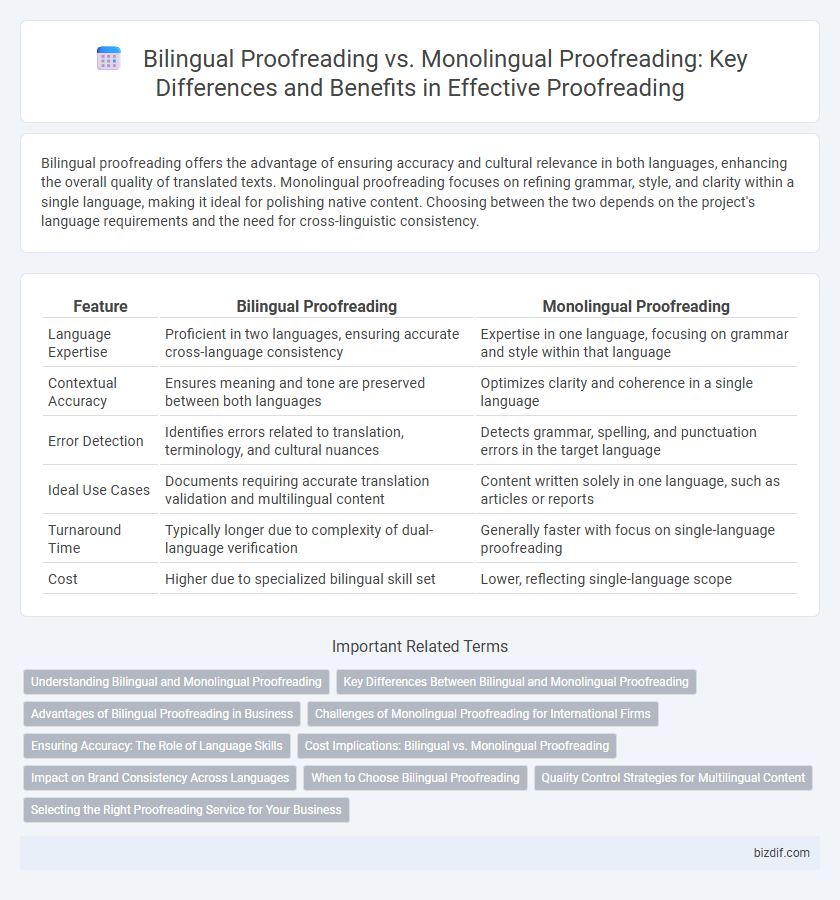Bilingual proofreading offers the advantage of ensuring accuracy and cultural relevance in both languages, enhancing the overall quality of translated texts. Monolingual proofreading focuses on refining grammar, style, and clarity within a single language, making it ideal for polishing native content. Choosing between the two depends on the project's language requirements and the need for cross-linguistic consistency.
Table of Comparison
| Feature | Bilingual Proofreading | Monolingual Proofreading |
|---|---|---|
| Language Expertise | Proficient in two languages, ensuring accurate cross-language consistency | Expertise in one language, focusing on grammar and style within that language |
| Contextual Accuracy | Ensures meaning and tone are preserved between both languages | Optimizes clarity and coherence in a single language |
| Error Detection | Identifies errors related to translation, terminology, and cultural nuances | Detects grammar, spelling, and punctuation errors in the target language |
| Ideal Use Cases | Documents requiring accurate translation validation and multilingual content | Content written solely in one language, such as articles or reports |
| Turnaround Time | Typically longer due to complexity of dual-language verification | Generally faster with focus on single-language proofreading |
| Cost | Higher due to specialized bilingual skill set | Lower, reflecting single-language scope |
Understanding Bilingual and Monolingual Proofreading
Bilingual proofreading involves reviewing texts in two languages to ensure accuracy, consistency, and cultural relevance, making it essential for international business communications and translation projects. Monolingual proofreading focuses on correcting grammar, spelling, and syntax errors within a single language, emphasizing linguistic precision and clarity. Understanding the differences between bilingual and monolingual proofreading enables tailored editing approaches that meet specific language and audience needs, enhancing the overall quality of written content.
Key Differences Between Bilingual and Monolingual Proofreading
Bilingual proofreading involves reviewing texts written in two languages, ensuring linguistic accuracy, cultural relevance, and consistency across both languages, while monolingual proofreading focuses solely on grammar, spelling, punctuation, and style within a single language. Bilingual proofreaders must possess deep knowledge of linguistic nuances, idiomatic expressions, and cultural contexts to maintain the message's integrity, whereas monolingual proofreaders emphasize clarity, coherence, and adherence to language-specific standards. The key difference lies in bilingual proofreading's added complexity of cross-language validation, which demands advanced skills in translation accuracy and intercultural communication compared to the primarily grammatical focus of monolingual proofreading.
Advantages of Bilingual Proofreading in Business
Bilingual proofreading enhances accuracy by ensuring content aligns with cultural nuances and idiomatic expressions essential for international markets, reducing misunderstandings and improving brand credibility. It streamlines communication across diverse linguistic audiences, increasing the effectiveness of marketing materials and legal documents in multiple languages. Businesses benefit from consistent messaging and a competitive edge by tapping into bilingual proofreading expertise that monolingual services cannot provide.
Challenges of Monolingual Proofreading for International Firms
Monolingual proofreading often overlooks cultural nuances and idiomatic expressions crucial for international firms, leading to misinterpretations and reduced global brand resonance. This approach may fail to detect language-specific errors or regional variations, resulting in content that lacks local relevance and authenticity. Consequently, international companies face challenges in maintaining consistent communication quality and establishing trust across diverse linguistic markets.
Ensuring Accuracy: The Role of Language Skills
Bilingual proofreading enhances accuracy by enabling proofreaders to directly compare both source and target texts, identifying subtle errors that monolingual proofreaders might miss due to lack of full context. Proficient language skills in both languages allow for nuanced understanding of idiomatic expressions, cultural references, and syntactic structures, ensuring error-free and contextually appropriate content. This dual-linguistic competence reduces the risk of mistranslations and preserves the original message's intent, critical for high-quality multilingual communication.
Cost Implications: Bilingual vs. Monolingual Proofreading
Bilingual proofreading typically incurs higher costs due to the specialized expertise required to accurately review and compare texts in two languages, often demanding proficiency in linguistic nuances and cultural context. Monolingual proofreading tends to be more cost-effective as it focuses solely on grammar, punctuation, and style within one language, minimizing the complexity of the task. Businesses must weigh these cost implications against the necessity for linguistic accuracy in multilingual documents to determine the most economical and effective proofreading approach.
Impact on Brand Consistency Across Languages
Bilingual proofreading ensures brand consistency by accurately maintaining tone, style, and messaging across multiple languages, reducing the risk of misinterpretation and cultural inaccuracies. Monolingual proofreading, while effective for single-language texts, may fail to capture nuanced linguistic differences necessary for coherent multilingual branding. Ensuring consistency in multilingual content supports stronger global brand identity and enhances audience trust.
When to Choose Bilingual Proofreading
Bilingual proofreading is essential when working with texts that require accuracy in two languages, such as international business documents, legal contracts, or marketing materials targeting diverse audiences. It ensures both linguistic correctness and cultural relevance, which monolingual proofreading cannot fully address. Choose bilingual proofreading when the source and target languages are both critical to maintaining the integrity and intent of the content.
Quality Control Strategies for Multilingual Content
Bilingual proofreading enhances quality control for multilingual content by ensuring accurate linguistic and cultural nuances in both source and target languages, reducing errors that monolingual proofreading may overlook. This strategy involves cross-referencing translations to maintain consistency and preserves meaning across languages, improving overall content accuracy. Implementing bilingual proofreading supports comprehensive quality assurance processes essential for global communication and brand integrity.
Selecting the Right Proofreading Service for Your Business
Selecting the right proofreading service for your business depends on whether your content requires bilingual proofreading or monolingual proofreading. Bilingual proofreading ensures accuracy and cultural relevance across languages, ideal for companies targeting international markets or multilingual audiences. Monolingual proofreading focuses on grammar, style, and consistency within a single language, enhancing clarity and professionalism for content aimed at native speakers.
bilingual proofreading vs monolingual proofreading Infographic

 bizdif.com
bizdif.com